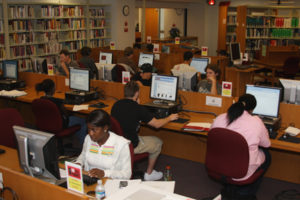
School libraries are an important resource that should be leveraged as state and local leaders implement the recommendations in the National Education Technology Plan, the American Library Association (ALA) says.
In comments filed with the U.S. Department of Education (ED) on May 17, ALA said it applauds many of the plan’s recommendations. The organization also stated its case for why school librarians should play a key role in state and local discussions on school technology use.
“The school librarian, as an expert in new and emerging information and communication tools, intellectual property issues, … new interpretations of fair use and use of Creative Commons licensing, … and information literacies—now often referred to as “transliteracies”—is a critical team member,” ALA said.
“Including school librarians in the discussions of how to incorporate meaningful uses of technology into the education system will help ensure effective and sustainable decisions are made and implemented successfully.”
In its filing, ALA listed examples of how school libraries are “at the forefront of creative, meaningful, ethical, and innovative technology integration in many schools throughout the country.”
For instance, the school librarian at Chesapeake High School in Baltimore County, Md., was heavily involved in the school’s creation of a 3-D research and learning lab, ALA said—where students combine traditional research done in the school library with virtual learning environments in a program that has helped boost the school’s enrollment.
The organization also responded to many of the specific recommendations in the national ed-tech plan with its own observations.
In response to the plan’s idea that technology should facilitate 24-7 learning, ALA noted: “Use of technology outside of school varies depending on availability and socio-economic status. Devices such as cell phones, however, play an important role in bridging the digital divide. A Pew Study reports that 41 percent of teens from households earning less than $30,000 annually go online with their cell phone— and 21 percent of teens who do not otherwise go online do so with their cell phones.”
ALA also observed that many public and school libraries work together to support learning beyond the school walls.
“Partnerships include public libraries collaborating with teachers and school librarians in collecting resources that complement student research projects, offering online tutoring, and participating in classroom visits,” the group said.
“Additionally, many school librarians are finding ways to extend the libraries’ resources to be available on demand, outside of the school building, so that students’ information needs can be supported at the moment of need, rather than after the learning moment has passed.”
ALA explained: “Many school library … catalogs and databases can be accessed with a password from any computer or device with internet access. Many school librarians create and maintain rich virtual libraries, which present opportunities for hybrid instruction and learning well beyond traditional hours. A growing number offer presence and connections on social networks like Facebook, Flickr, and Twitter.”
As for the plan’s focus on teaching, ALA said it “strongly supports” the notion of “connected teaching” put forth by the national ed-tech plan—and it said school libraries play an important role in realizing this vision.
“Collaboration across disciplines is critical in order to address the learning needs of the students,” the organization said. “School librarians eagerly participate in team initiatives and collaborate daily with teachers to create a robust curriculum that meet state curriculum standards but often go beyond the minimum requirement to provide enriched learning experiences for students across grade levels.”
On the subject of schools’ ed-tech infrastructure needs, ALA said a study on public library connectivity found that successful libraries had effective leadership, a clear vision, a champion and other advocacy for the vision, strong partnerships, demonstration models, a solid technical plan, and staff training.
“As [ED] develops specific strategies to create an infrastructure for learning, ALA respectfully suggests that this public library model could be adapted to meet some of the needs of the education community at the state and local level,” the organization said.
ALA also said it agrees that many of the ed-tech plan’s recommendations rely on the success of the Federal Communications Commission’s National Broadband Plan.
“As schools move toward making 24-7 learning more common, there needs to be a recognition that this will challenge some students’ ability to keep up with their peers simply because they do not have access to home broadband,” ALA said. “The public library supports these students, as well as students who may not have a robust enough home connection to effectively participate in online activities. Just as [schools’] infrastructure … must support multiple users and heavy bandwidth use, so must public library infrastructure.”
Finally, regarding student productivity, this should be measured “in a way that reflects how their performance will be measured and evaluated in the future workplace,” ALA said. “The goal of any productivity measurement should be to support learners and provide them authentic feedback that they can use for continual improvement and growth.”
Links:
National Education Technology Plan
- ‘Buyer’s remorse’ dogging Common Core rollout - October 30, 2014
- Calif. law targets social media monitoring of students - October 2, 2014
- Elementary world language instruction - September 25, 2014

